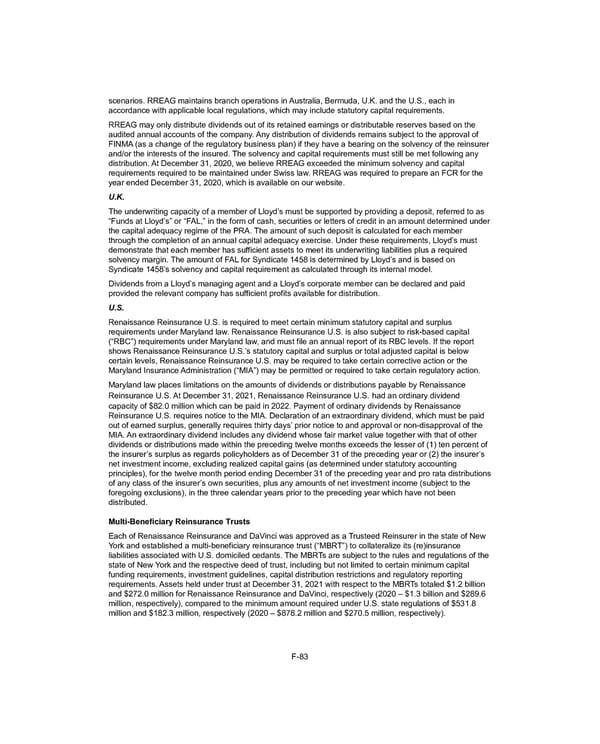scenarios. RREAG maintains branch operations in Australia, Bermuda, U.K. and the U.S., each in accordance with applicable local regulations, which may include statutory capital requirements. RREAG may only distribute dividends out of its retained earnings or distributable reserves based on the audited annual accounts of the company. Any distribution of dividends remains subject to the approval of FINMA (as a change of the regulatory business plan) if they have a bearing on the solvency of the reinsurer and/or the interests of the insured. The solvency and capital requirements must still be met following any distribution. At December 31, 2020, we believe RREAG exceeded the minimum solvency and capital requirements required to be maintained under Swiss law. RREAG was required to prepare an FCR for the year ended December 31, 2020, which is available on our website. U.K. The underwriting capacity of a member of Lloyd’s must be supported by providing a deposit, referred to as “Funds at Lloyd’s” or “FAL,” in the form of cash, securities or letters of credit in an amount determined under the capital adequacy regime of the PRA. The amount of such deposit is calculated for each member through the completion of an annual capital adequacy exercise. Under these requirements, Lloyd’s must demonstrate that each member has sufficient assets to meet its underwriting liabilities plus a required solvency margin. The amount of FAL for Syndicate 1458 is determined by Lloyd’s and is based on Syndicate 1458’s solvency and capital requirement as calculated through its internal model. Dividends from a Lloyd’s managing agent and a Lloyd’s corporate member can be declared and paid provided the relevant company has sufficient profits available for distribution. U.S. Renaissance Reinsurance U.S. is required to meet certain minimum statutory capital and surplus requirements under Maryland law. Renaissance Reinsurance U.S. is also subject to risk-based capital (“RBC”) requirements under Maryland law, and must file an annual report of its RBC levels. If the report shows Renaissance Reinsurance U.S.’s statutory capital and surplus or total adjusted capital is below certain levels, Renaissance Reinsurance U.S. may be required to take certain corrective action or the Maryland Insurance Administration (“MIA”) may be permitted or required to take certain regulatory action. Maryland law places limitations on the amounts of dividends or distributions payable by Renaissance Reinsurance U.S. At December 31, 2021, Renaissance Reinsurance U.S. had an ordinary dividend capacity of $82.0 million which can be paid in 2022. Payment of ordinary dividends by Renaissance Reinsurance U.S. requires notice to the MIA. Declaration of an extraordinary dividend, which must be paid out of earned surplus, generally requires thirty days’ prior notice to and approval or non-disapproval of the MIA. An extraordinary dividend includes any dividend whose fair market value together with that of other dividends or distributions made within the preceding twelve months exceeds the lesser of (1) ten percent of the insurer’s surplus as regards policyholders as of December 31 of the preceding year or (2) the insurer’s net investment income, excluding realized capital gains (as determined under statutory accounting principles), for the twelve month period ending December 31 of the preceding year and pro rata distributions of any class of the insurer’s own securities, plus any amounts of net investment income (subject to the foregoing exclusions), in the three calendar years prior to the preceding year which have not been distributed. Multi-Beneficiary Reinsurance Trusts Each of Renaissance Reinsurance and DaVinci was approved as a Trusteed Reinsurer in the state of New York and established a multi-beneficiary reinsurance trust (“MBRT”) to collateralize its (re)insurance liabilities associated with U.S. domiciled cedants. The MBRTs are subject to the rules and regulations of the state of New York and the respective deed of trust, including but not limited to certain minimum capital funding requirements, investment guidelines, capital distribution restrictions and regulatory reporting requirements. Assets held under trust at December 31, 2021 with respect to the MBRTs totaled $1.2 billion and $272.0 million for Renaissance Reinsurance and DaVinci, respectively (2020 – $1.3 billion and $289.6 million, respectively), compared to the minimum amount required under U.S. state regulations of $531.8 million and $182.3 million, respectively (2020 – $878.2 million and $270.5 million, respectively). F-83
 2021 Annual Report Page 225 Page 227
2021 Annual Report Page 225 Page 227